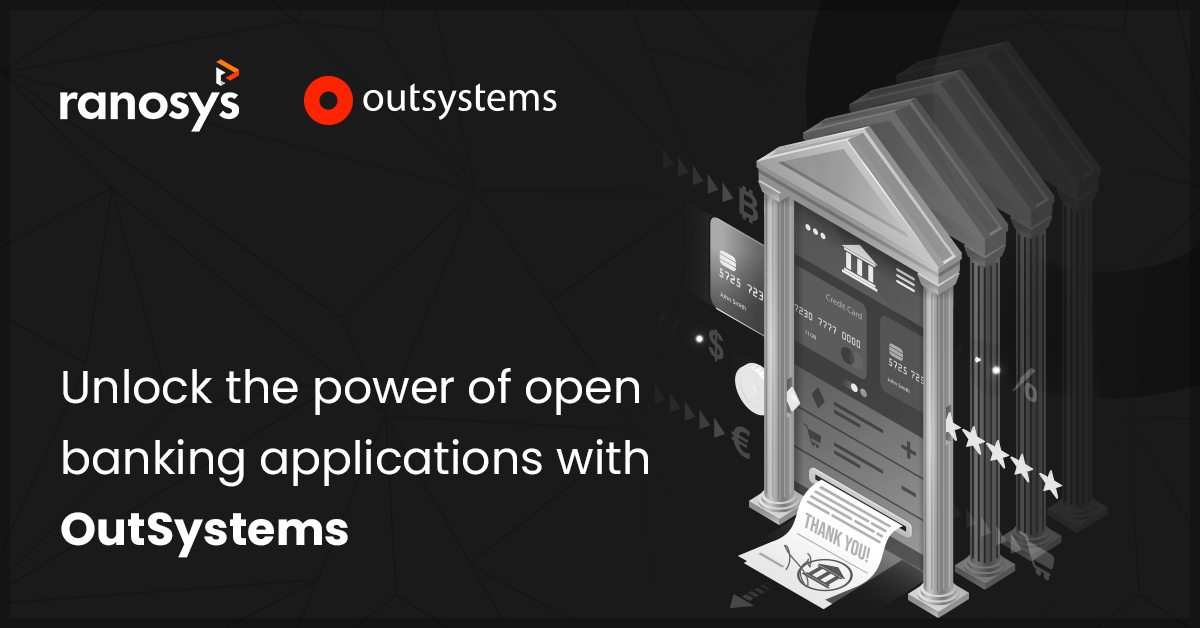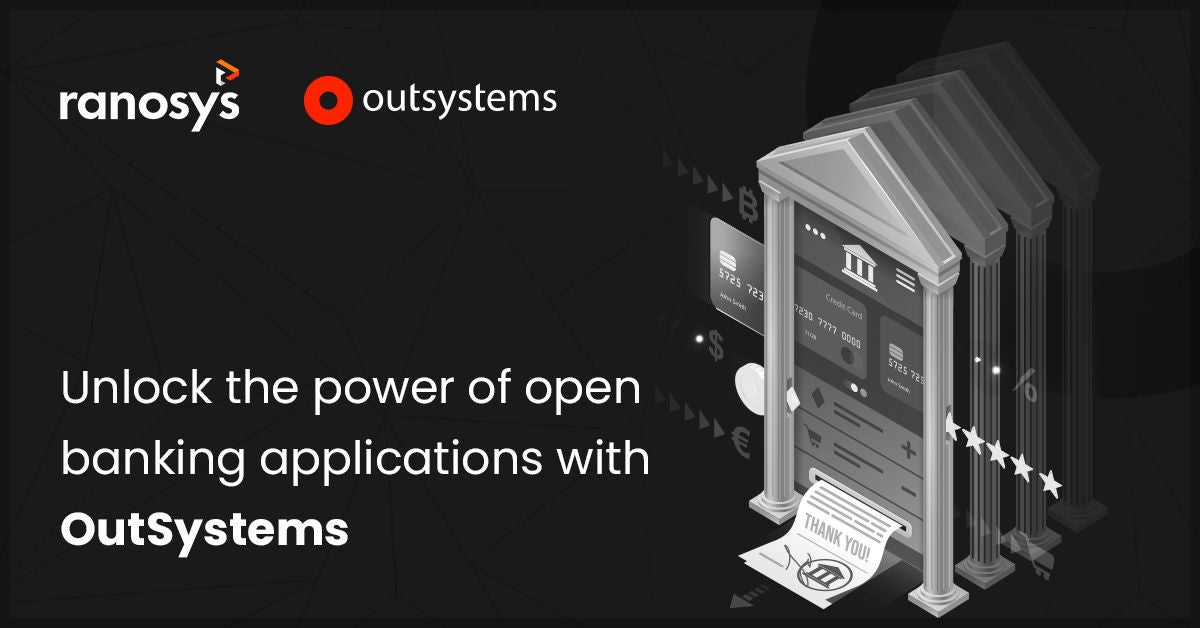The financial industry landscape is changing drastically, and customer technology expectations are dynamically shifting. Digital acceleration and advancements in the FinTech industry have opened a new era of banking. Banks are now more focused on providing customer experiences and digital-driven solutions. But thriving in this financial environment can be challenging as banks are facing competition from big tech and retailers for financial services and payments space. Hence, banks need to differentiate themselves, and open banking helps banks innovate, create new revenue streams, and offer new opportunities to serve their customers.
Here we will talk about what open banking is and how it will enhance customer experience, thoughts around embedded finance and Banking as a Service in the context of banking services, and the key capabilities of OutSystems low-code platform to build open banking applications.
What is open banking and how does it help in enhancing customer experiences?
Open banking is the practice in the banking industry which allows third-party applications to access customer data like transactions, bank balances, statements etc. Open banking features allows the banks to enhance the data and add new non-banking services through the use of API. Customers grant permissions to access their data usually via terms and conditions agreement. The third-party providers then access the relevant information through APIs.
Open banking is a major source of innovation that is poised to reshape the banking and FinTech industry by enhancing customer experience.
In today’s competitive landscape with increasing customer expectations, the FinTech industry must be flexible and adaptable and open banking offers them adaptability, convenience, cost reduction, centralized information and much more. Let’s see why open banking matters:
#1. Incorporate new technologies
BFSI industries connect with technology providers for plugins without developing new applications. The platform enables banks or FinTech organizations to add modern features like video chat, digital account opening, and real-time money transfer much faster.
#2. Consolidate data
APIs create a standard language to share data seamlessly across banking systems and processes in real-time. With centralized behavioral and transactional data accessible in CRM and analytics dashboards of banking institutes to make customer needs better. Consolidating data can be used in journey mapping to determine where potential customers are lost allowing organizations to gain insight into financial conditions of customers and provide them with support to convert them into opportunities.
#3. Automate backend processes
Open banking allows to unify data from disparate systems so that financial institutions eliminate dual data entry and gain time to focus on customers. It offers pre-built workflows and task automation for account opening, customer service, and transactions. The system connected to an open platform can automate data entry for returning customers and use auto-decisioning to review credit and fraud risks. These steps improve the employee experience and allow frontline employees to focus on customer needs.
Open banking enables you to have better payment solutions for businesses improving cash flow, reducing costs, increasing visibility, and reducing fraudulent occurrences. Also the bank history can help users to get credit by analyzing creditworthiness.
The ecosystem: Open Banking, Embedded finance, and Banking as a Service(BaaS)
Open banking leads to embedded finance, which is a step ahead. Embedded finance integrates banking capabilities into non-financial services such as cashless payments, in-game purchases, integration of e-wallets, etc. It also includes credit, insurance, and investments from external companies.
Banking as a Service (BaaS) makes financial organizations' digital services available on a third party's platform, offering customers things like payment services and loans without acquiring a banking license.
How open banking and embedded finance is extending banking services?
- With the changing dynamics of customers' expectations, banks are now preparing themselves with a layer of microservices that other applications can easily call. Programmatic APIs allow banks to embed, extend, and distribute services seamlessly with internal or verified external applications.
- It also enables the banking community access to their data, such as spending and earning patterns, and the use of other non-banking apps.
With the OutSystems low-code platform, a bank can quickly build a diverse suite of applications that allows customers to manage their money in an intelligent way that is personalized to their needs.
How OutSystems leverage low-code to develop open banking applications?
To win in today's competitive financial landscape, banks need to differentiate themselves with superior digital solutions, omnichannel experiences, and custom applications. They need to integrate with the help of robust APIs and OutSystems high performance low-code is the ideal solution for designing and building innovative open banking applications for the FinTech industry. Let’s discuss key capabilities of OutSystems low-code platform to develop open banking applications:
#1. Legacy system modernisation
As the finance industry evolves, institutions need to keep up with ongoing technological trends to compete. Legacy systems can hinder progress with slow and manual systems and technologies that simply cannot keep up with the demands of today’s customers.
How OutSystems helps:
- OutSystems amplifies open banking applications to build new front-ends for current systems to support new customized processes and improved user experiences.
- The BFSI industry can decouple and refactor open banking benefits to create a modular composable architecture that can change easily and take better advantage of cloud models.
- For legacy modernization OutSystems can build open banking applications that fits systems tailored to users needs for competing effectively without the risk, cost and complexity of traditional development and without limitation of COTS solution.
- Low-code cloud native OutSystems platform provides a visual, model-driven approach, drag and drop data connections and AI-powered tools that improve the application lifecycle and facilitate app modernization.
#2. Handling and reducing technical debt
Technical debt is costing banks innovation and agility which makes them unable to provide seamless customer experiences to users. With technical debt, banks become more vulnerable to cybersecurity. The main challenge is that banks don’t want to develop hundreds of applications, hence a low-code platform like OutSystems enables institutions to overcome technical debt by its modernization approach.
How OutSystems helps:
- OutSystems approach is based on building open APIs, microservices, containerization, pre-built templates like OutSystems Forge making development faster and easy to code for developers.
- OutSystems helps reduce technical debt during development with its best practices of modular architecture.
- The open banking apps built with OutSystems uses automation, AI, ML, and analytics to identify architecture errors, faulty logic, and broken dependencies during development in real-time.
#3. Visual-based development
Customers want a digital banking platform to be simple and user-friendly. They want processes like account opening, loan application, finding nearby ATMs and branches, transaction confirmations, easy checkout etc. OutSystems employs a visual programming language that enables to reduce the complexity of modern application development.
How OutSystems helps:
- OutSystems allows banking and financial institutions to create intuitive experiences with its Experience Builder and offers clean UX interfaces, leverage innovative technologies to simplify data entry and utilize customized pre-filled forms to avoid reputation of data. It can also build dedicated workflows, for automation of sign-up approvals without the need for human intervention.
- OutSystems low-code develops its own API platforms, enabling banking organizations to design and deliver embedded finance services backed by banking infra and compliance capabilities.
- You can utilize the drag and drop UIs, business intelligence, and data models to build mobile applications, automate workflows, and custom-fit business process applications.
- OutSystems pre-built code modules available in centralized repositories offers high value and innovative features and capabilities like camera access, GPS maps, paper from scans, loan calculation, signature pads, etc.
#4. Enterprise grade security
In the BFSI industry privacy and the security of consumer finance are the main concerns for anyone involved in the open banking environment. Malicious third-party applications could access a customers account, breach and hack data streams, result in insider threats etc. OutSystems can help open banking and financial applications to build safe, transparent, and trustworthy relationships between banks, consumers, and businesses.
How OutSystems helps:
- OutSystems works inside a secure runtime environment and the tools necessary for secure development.
- OutSystems provides a dedicated Computer Security Incident Response Team (CSIRT) for managing security threats 24/7 and proactively monitoring industry sources for newly discovered security vulnerabilities.
- OutSystems enables real-time service responses with automated controls and compliance processes that balance security and speed.
- With OutSystems, you can automatically address internal operational mandates as well as KYC, fraud detection, due diligence checks, and disclosure management.
- The OutSystems App Shield and Sentry features allow you to build secure applications reducing risk and regulatory compliance.
#5. Integrating Open APIs
Open banking APIs development makes information about its customers personal or commercial accounts more accessible externally through the interfaces. Ofcourse, there are risks caused by using open banking APIs like inauthentic applications, security, API testing and validation. OutSystems high-performance low-code capabilities have built-in capabilities and automation that significantly reduce the time-consuming effort it takes to integrate databases, systems and software.
How OutSystems helps:
- OutSystems makes integrations with SOAP web services, REST APIs and SAP systems are built-in generating all the methods and data structures increasing collaboration between teams.
- OutSystems can manage integration centrally at runtime and no-code is required.
- OutSystems connects central management consoles built into OutSystems developers can integrate faster, transfer knowledge quickly.
Make banking easy, frictionless, and automated with a trusted OutSystems partner.
Open banking APIs are the road ahead for banks to offer the services needed to compete and remain relevant in today's digital world. OutSystems high-performance, low-code development platform enables banks to create custom digital solutions that can differentiate and meet customers' evolving demands. As an OutSystems Partner, we have assisted several banking and financial organizations in building open banking applications, and we can accomplish your business cases too. Connect with our certified experts to know how OutSystems banking can digitally transform your firm.






